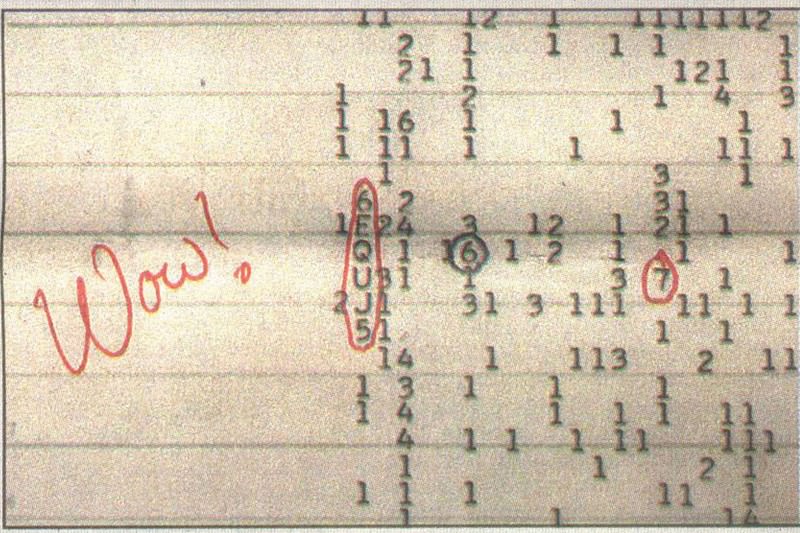

No point-like features significantly exceeding the noise were found inside the full width at half maximum of the OSU fields of view, although one 26σ point-like feature was detected during one 10 second integration about 1/3° away. Other articles where Wow signal is discussed: extraterrestrial intelligence: Results and two-way communication: these was the so-called Wow signal. This allows identification of the DOA of a very brief repetition, with strong discrimination from radio interference, and eliminates the usual constraint that the signal must persist for long periods of time (around one hour) before the true DOA can be verified (because interfering signals from the horizon sometimes masquerade as coming from the look direction). We used interferometric imaging with an angular resolution of approximately 0☀7 and automated feature-finding to search for point-like features mimicking a Wow repetition, obtaining single-channel sensitivity of ∼1.2 Jy for one minute averages. Approximately 100 hours of data were accumulated, considerably more time than any previous follow-up campaigns. While previous follow-up searches have reported null results, our observations covered a 5 deg 2 field of view that extends well beyond the locus of all consistent directions of arrival (DOAs) of the original signal, and covered a 10 MHz bandwidth four times wider than the widest prior follow-up observations, using 12.8 kHz channels approximating OSU's 10 kHz resolution. And perhaps the real lesson is that the 1420 MHz band emitted naturally by hydrogen might not be the best frequency to search for messages from extraterrestrial civilizations, given that there are many natural sources in that window.The Allen Telescope Array was used to search for signals with characteristics similar to the "Wow" signal, the best candidate for an extraterrestrial radio signal found during Ohio State University's (OSU's) seven-year 21 cm 10-kHz channel sky survey for signals possibly due to extraterrestrial intelligence. Even though the new study makes a strong case for a natural source, this is probably not the last time we’ll hear about the Wow! signal. But the short duration of the detection, 72 seconds, was due to technical limitations of the Big Ear Telescope, and so is consistent with both explanations.įor most of us, an artificial source of the signal, such as the one William Bains suggested in 2015, would be much more exciting. Also, the bandwidth of the 1977 signal was extremely narrow-about 10 kHz-which is difficult to explain with a natural source, but would be more consistent with a strong, narrow-band artificial transmitter. The comet and its signal should have been measurable for days, and perhaps weeks, after the initial detection.

What is more difficult to explain-and what Paris does not discuss-is why Ehman and his colleagues could not find the Wow! signal again when they pointed the Big Ear Telescope at least 50 more times in the same direction. Paris, however, thinks that could be because comet 266/P Christensen had much more mass 40 years ago, which it has subsequently lost. His conclusion: The Wow! signal came from a natural source rather than from an extraterrestrial civilization.Īdvocates of an artificial source point to the extraordinary strength of the 1977 signal.

But when he moved back to the target, the radio signal could again be detected at the same frequency. When the telescope was moved 1 degree away from the comet, no signal could be observed. He found that various natural sources have a strong signal at 1420 MHz, and that the peak intensity of Comet 266/P Christensen is particularly strong. For the new study, Paris conducted more than 200 observations between November 2016 and February 2017 with a 10-meter radio telescope. They reached that conclusion after extrapolating the comet’s trajectory back to 1977. Paris and co-author Evan Davies suggested in a paper published last year that the comet 266/P Christensen, which was discovered nine years after the Wow! signal, was in the celestial vicinity of the signal at the time it was detected, and might in fact have been the source. Petersburg College in Florida provides further evidence that the signal was most likely caused by a natural source such as a comet. In a recent re-analysis of the Wow! signal, Antonio Paris from the Center for Planetary Science at St. The signal was unusual, and, when reviewing the. Now that interpretation is being called into question. The Wow signal was detected on Augat the Big Ear Radio Observatory in Ohio, during a search for signs of extraterrestrial intelligence. It has remained the best evidence to date for a signal that might have come from an extraterrestrial civilization. The Wow! signal was a strong, narrow-band radio signal in the frequency range of 1420 MHz discovered in 1977 by radio astronomer Jerry Ehman after reviewing recorded data from Ohio State’s Big Ear Telescope.


 0 kommentar(er)
0 kommentar(er)
